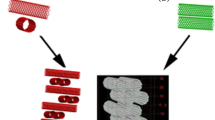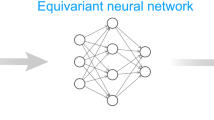Abstract
Based on molecular mechanics, a structural mechanics model of carbon nanotubes (CNTs) was developed with special consideration given to the bending stiffness of the graphite layer. The potentials associated with the atomic interactions within a CNT were evaluated by the strain energies of beam elements which serve as structural substitutions of covalent bonds in a CNT. In contrast to the original model developed by Li and Chou (Int. J. Solids Struct. 40(10):2487–2499, 2003), in the current model the out-of-plane deformation (inversion) of the bond was distinguished from the in-plane deformation by considering a rectangular cross-section for the beam element. Consequently, the model is able to study problems where the effect of local bending of the graphite layer in a carbon nanotube is significant. A closed-form solution of the sectional properties of the beam element was derived analytically. The model was verified through the analysis of rolling a graphite sheet into a carbon nanotube. Using the present model, the buckling behavior of nanotubes under bending is simulated. The predicted critical bending angle agrees well with molecular dynamics simulations.
Similar content being viewed by others
References
Li C, Chou T-W (2003) A structural mechanics approach for the analysis of carbon nanotubes. Int J Solids Struct 40(10):2487–2499
Harik VM (2001) Ranges of applicability for the continuum beam model in the mechanics of carbon nanotubes and nanorods. Solid State Commun 120:331–335
Yakobson BI, Brabec CJ, Bernholc J (1996) Nanomechanics of carbon tubes: Instabilities beyond linear response. Phys Rev Lett 76(14):2511
Ru CQ (2000) Effective bending stiffness of carbon nanotubes. Phys Rev B 62(15):9973
Shen L, Li J (2005) Equilibrium structure and strain energy of single-walled carbon nanotubes. Phys Rev B (Condens Matter Mater Phys) 71(16):165427-8
Chang T, Gao H (2003) Size-dependent elastic properties of a single-walled carbon nanotube via a molecular mechanics model. J Mech Phys Solids 51:1059–1074
Shen L, Li J (2004) Transversely isotropic elastic properties of single-walled carbon nanotubes. Phys Rev B (Condens Matter Mater Phys) 69(4):045414-10
Odegard GM, Gates TS, Nicholson LM, Wise KE (2002) Equivalent-continuum modeling of nano-structured materials. Compos Sci Technol 62:1869–1880
Huang M-Y, Chen H-B, Lu J-N, Lu P, Zhang P-Q (2006) A modified molecular structural mechanics method for analysis of carbon nanotubes. Chinese J Chem Phys 19(4):286–290
Li C, Chou T-W (2004) Modeling of elastic buckling of carbon nanotubes by molecular structural mechanics approach. Mech Mater 36:1047–1055
Li C, Chou T-W (2005) Modeling of carbon nanotube clamping in tensile tests. Compos Sci Technol 65:2407–2415
Tu Z-C, Ou-Yang Z-C (2002) Single-walled and multiwalled carbon nanotubes viewed as elastic tubes with the effective Young’s moduli dependent on layer number. Phys Rev B 65:233407
Kundin KN, Scuseria GE, Yakobson BI (2001) C2f, bn, and c nanoshell elasticity from ab initio computations. Phys Rev B 64:235406
Pantano A, Parks DM, Boyce MC (2004) Mechanics of deformation of single- and multi-wall carbon nanotubes. J Mech Phys Solids 52(4):789–821
Zhou X, Zhou JJ, Ou-Yang ZC (2000) Strain energy and Young’s modulus of single-wall carbon nanotubes calculated from electronic energy-band theory. Phys Rev B 62(20):13692–13696
Robertson DH, Brenner DW, Mintmire JW (1992) Energetics of nanoscale graphitic tubules. Phys Rev B 45(21):12592
Miyamoto Y, Rubio A, Louie SG, Cohen ML (1994) Electronic properties of tubule forms of hexagonal bc_{3}. Phys Rev B 50(24):18360
Kurti J, Kresse G, Kuzmany H (1998) First-principles calculations of the radial breathing mode of single-wall carbon nanotubes. Phys Rev B 58(14):R8869
Sanchez-Portal D, Artacho E, Soler JM, Rubio A, Ordejon P (1999) Ab initio structural, elastic, and vibrational properties of carbon nanotubes. Phys Rev B 59(19):12678
Hernandez E, Goze C, Bernier P, Rubio A (1998) Elastic properties of c and b x c y n z composite nanotubes. Phys Rev Lett 80(20):4502
Mylvaganam K, Vodenitcharova T, Zhang LC (2006) The bending-kinking analysis of a single-walled carbon nanotube—a combined molecular dynamics and continuum mechanics technique. J Mater Sci 41:3341–3347
Tu ZC, Ou-Yang ZC (2008) Elastic theory of low-dimensional continua and its applications in bio- and nano-structures. J Comput Theor Nanosci 5:422–448
Author information
Authors and Affiliations
Corresponding author
Rights and permissions
About this article
Cite this article
Wan, H., Delale, F. A structural mechanics approach for predicting the mechanical properties of carbon nanotubes. Meccanica 45, 43–51 (2010). https://doi.org/10.1007/s11012-009-9222-2
Received:
Accepted:
Published:
Issue Date:
DOI: https://doi.org/10.1007/s11012-009-9222-2




